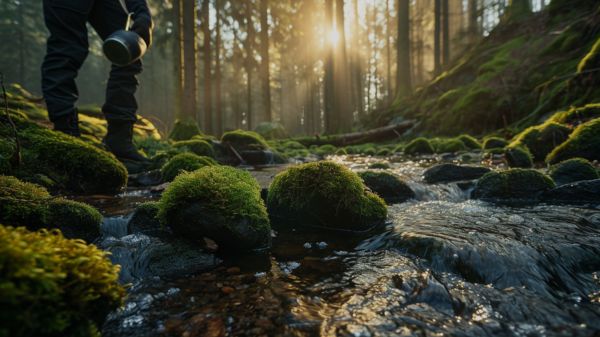For your off-grid living needs, consider these five essential water sources. Rainwater harvesting systems capture and store rain efficiently, while groundwater wells tap into underground aquifers providing a steady supply. You can also rely on natural spring water, which offers cleanliness enhanced by natural filtration.
Surface water collection from local bodies of water is feasible with proper filtration to guarantee safety. Finally, atmospheric water generators condense moisture from the air, offering a sustainable solution in diverse environments. Each method supports a sustainable lifestyle and varies in long-term viability and environmental impact.
Exploring further could open up new insights into maintaining an efficient off-grid water system.
Key Takeaways
- Rainwater harvesting systems capture and store rainwater, providing a reliable and clean water source with minimal environmental impact.
- Groundwater wells tap into underground aquifers, offering a consistent and often abundant water supply.
- Natural spring water is a sustainable source, rich in minerals and naturally filtered, bypassing industrial contaminants.
- Surface water collection utilizes rivers and lakes, requiring effective filtration to ensure safety and availability throughout the seasons.
- Atmospheric water generators condense air moisture into drinkable water, ideal for diverse environments and reducing dependence on traditional water sources.
Rainwater Harvesting Systems
Rainwater harvesting systems effectively capture and store rainwater, providing a reliable water source for off-grid living. Imagine this: every drop of rain that hits your roof could be your next glass of water—talk about making it rain! But before you start guzzling, you’ll need a solid game plan for filtering and storing that sky juice.
The initial system includes gutters and downspouts, which help channel rainwater into storage tanks for collection. But the rainwater doesn’t just go straight from the roof to your glass. After collecting the rainwater, consider using a first-flush diverter, which guarantees that the initial runoff, carrying most of the dirt and debris, doesn’t make it into your storage.
Then, a set of fine filters can take care of the smaller particles. This filtration system is vital for removing debris, sediments, and contaminants from the collected water. It’s like giving your water a spa day before it hits your glass.
Next, storage solutions are important. You’ll need a robust system that doesn’t let your harvested water turn into a science experiment. Opt for dark, UV-resistant tanks to prevent algae growth and maintain water quality. And size matters—verify your tank is big enough to get you through dry spells but not so big that you’re auditioning for a role in “Waterworld.”
Groundwater Wells
While rainwater harvesting captures water from the sky, drilling a groundwater well taps into a more constant underground source, offering a dependable supply even during dry periods.
Just like how off-grid solar systems provide a consistent source of energy, groundwater wells provide constant water supply. You’re not just poking around in the dirt; you’re tapping into ancient aquifers with techniques honed since your ancestors thought drinking rainwater was cutting-edge!
Drilling your own well isn’t just about putting a big straw into the ground and hoping for the best. It involves choosing the right drilling techniques to meet the geological challenges of your location. Whether it’s rotary, cable tool, or sonic, each method has its quirks. Sonic drilling, for instance, is like the smooth jazz of drilling, gentle on the environment yet effective.
But let’s not forget well maintenance, which can be as essential as the drilling itself. Think of it as dental care for your well: regular check-ups prevent major issues. Neglecting this can lead to a well that’s about as useful as a chocolate teapot. Regular cleaning, timely repairs, and consistent monitoring of water quality keep your water source reliable and safe.
Natural Spring Water
Many off-grid enthusiasts turn to natural spring water as a sustainable and reliable water source. Now, don’t just think of this as your typical bottled water aisle find. This is about tapping directly into nature’s hydration station.
Spring water surfaces through natural filtration processes—think of it as Earth’s own Brita filter—making it not only cleaner but also tasting like it’s straight from a mountain brochure.
Alongside this, embracing natural spring water can be seen as part of a broader move towards water conservation and energy efficiency. This aligns with a number of other strategies, such as utilizing rainwater harvesting methods or implementing efficient plumbing fixtures.
Here’s the scoop: spring water benefits extend beyond just quenching your thirst. It often contains minerals that are beneficial for your health. We’re talking magnesium, calcium, and sometimes even traces of natural electrolytes without the sugar rush of those neon sports drinks.
Plus, you’re bypassing the whole industrial processing scene which means fewer contaminants and no need for artificial purification that can strip away beneficial minerals.
To harness this resource, you’ll need to identify a reliable spring, which can be an adventure in itself. You’re not just looking for any damp spot; you need a flowing spring that has been tested for quality and sustainability.
Surface Water Collection
After exploring the benefits of natural spring water, let’s consider another sustainable approach: surface water collection. You’ve got rivers, lakes, and that moody beast we call seasonal rain. One of the most eco-friendly and cost-effective methods to harness this source is through rainwater harvesting.
By installing a simple setup, you can collect and store rainwater for various uses, from drinking to irrigation. Collecting surface water isn’t just scooping up a bucketful and calling it a day—oh no, it’s an art form, especially when you’re playing dodgeball with debris and contaminants.
Here’s the scoop: surface water filtration is essential. It’s not just about keeping the floaties out of your glass (though, admittedly, that’s a big plus). Effective filtration systems remove harmful bacteria and sediments, ensuring that the water isn’t just safe to drink but also won’t prematurely age your plumbing with sedimentary souvenirs.
Think of it as giving your water a spa day—every day.
Now, let’s chat about seasonal water availability. It’s like that friend who says they’ll show up and sometimes does—or doesn’t. Depending on the time of year, the abundance of surface water can vary, which means your collection strategy needs to be as flexible as your yoga instructor. In dryer months, your stored water from rainier times becomes your best pal, proving that in water collection, timing is everything.
Atmospheric Water Generators
Shifting our focus to a remarkable technology, atmospheric water generators (AWGs) present a forward-thinking solution to water scarcity.
Now, you might be wondering, “What’s an AWG?” Well, imagine a device that’s like a magician pulling water out of thin air—literally. AWGs use a nifty bit of science to condense moisture from the air and turn it into water. It’s not quite pulling a rabbit out of a hat, but it’s close!
The atmospheric water production isn’t just a neat party trick. It has serious benefits, especially if you’re living off-grid and clean water is as hard to find as a decent cell signal. These devices can produce water anywhere, from the arid desert to your misty mountaintop retreat, reducing reliance on traditional water sources which can be contaminated or overly taxed.
One of the top atmospheric water generator benefits is its sustainability. You’re not depleting any natural resources, just borrowing a bit from the humidity in the air. Plus, it’s a system that keeps on giving as long as there’s air around, which last time I checked, was pretty abundant. So, if you’re looking to quench your thirst for both water and innovation, AWGs might just be your new best friend.
Turn Air into Water: Secure Your Future with Air Fountain
Frequently Asked Questions
How Do Legal Restrictions Affect Off-Grid Water Collection?
You’ve got to navigate a maze of legalities to collect water off-grid. State laws, water rights, and environmental regulations dictate what you can do. You’ll need collection permits, especially if your setup crosses property boundaries. Usage restrictions often hinge on sustainability concerns. So, before you redirect that stream to a personal oasis, check the fine print or you might be up the creek—pun intended—without a legally sourced paddle!
What Are the Initial Costs of Setting up Off-Grid Water Systems?
When diving into off-grid water systems, your initial investment isn’t just a drop in the bucket. It depends heavily on system components like pumps, filters, and storage units. Costs can range widely, from a few hundred bucks for a basic setup to thousands for a state-of-the-art system.
How Do I Test Water Quality in Off-Grid Systems?
Before you gulp down that mysterious off-grid H2O, let’s make certain it’s not a potion of surprises. To test water quality, you’ll want to grab a testing kit that measures contaminants like bacteria, nitrates, and pH levels. Analyze the results carefully and if they’re sketchy, consider various purification methods. Remember, your health’s at stake! So, plunge into those details and let the water testing guide your path to sustainable, clean hydration.
What Are the Maintenance Requirements for Off-Grid Water Systems?
For your off-grid water systems, regular maintenance is a must. You’ll need to set up and stick to maintenance schedules to guarantee your water filtration remains effective. Clean and replace filters as recommended, check for leaks, and monitor system performance. It’s like giving your water system a spa day—only you’re the one doing the pampering! Stay proactive to keep your water clean and flowing smoothly.
Can Off-Grid Water Systems Support Large Families or Communities?
Off-grid water systems, like rainwater harvesting and community wells, are more than capable of quenching the thirst of large clans or even small towns. By focusing on sustainable sourcing and efficient resource management, you’ll guarantee that family needs are consistently met. While these systems require a bit of elbow grease and a hearty dose of cooperation, they’re a brilliant way to keep everyone’s water glasses more than half full!
Conclusion
As you consider shifting to off-grid living, remember that water sourcing is essential. Among these options, rainwater harvesting is particularly sustainable, capturing up to 600 gallons per 1,000 square foot of roof in a single inch of rainfall. This method not only reduces dependency on traditional water systems but also promotes a sustainable cycle of consumption and renewal. Choose wisely and sustainably, ensuring your water source aligns with both your environmental values and practical needs.




